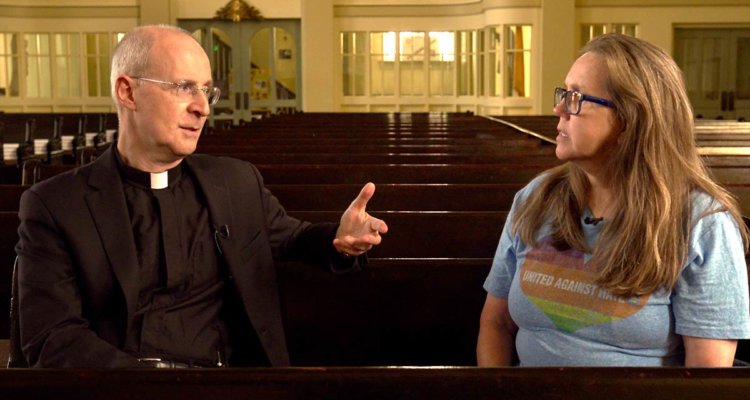Based, in part, on Father James Martin’s bestselling book “Building a Bridge: How the Catholic Church and LGBT Community Can Enter into a Relationship of Respect, Compassion, and Sensitivity,” Evan Mascagni and Shannon Post’s compassionate documentary “Building a Bridge” use Martin as an entry point into a larger discourse surrounding the relationship between the Catholic Church and the LGBTQ+ community. Mainly tracking Martin’s packed schedule, as he moves from interview to lecture to book signing, accruing equal parts admiration and scorn from various sects of the Church, Mascagni and Post’s film borders on the hagiographic. Yet, it interrogates the narrow scope of Martin’s position and the Church as a whole, just enough to complicate the idea of what such a bridge between these two communities might look like. In all, “Building a Bridge” is an engrossing dive into the complicated negotiations between the two opposing communities.
READ MORE: 2021 Tribeca Film Festival Preview: 15 Must-See Films To Watch & More
Executive produced by Martin Scorsese — the patron saint of filmed Catholic guilt — “Building a Bridge” explores the so-called “early spring” between the Church and the Queer communities, right after Pope Francis’ famous “who am I to judge” comment seemingly opened up discussions of LGBTQ+ acceptance within the Church. Martin’s book, which grew out of his personal reaction to the 2016 Pulse nightclub shooting, and his ensuing media tour, purports to open a dialogue between the two sides, initially suggesting a two-way bridge in which the two can meet and hash out ideological differences. Martin comes across as humane but nevertheless driven in his mission to preach acceptance, viewing himself as a reluctant leader of a movement that simultaneously puts him at odds with accepted Church doctrine but also accepted by his higher-ups, who oddly remain on the periphery of the film.
Running counter to Martin is Michael Voris, a shaggy-haired founder of Church Militant, a name that blatantly signposts the organization’s intent. While given less screen time than Martin, Voris rhetorically acts as Martin’s inverse, crusading against the Priest and those who preach a doctrine of tolerance. Coming off as a deeply troubled man, tracking Voris is perhaps the film’s most contentious choice. By juxtaposing the two figures, the film flirts with a bilateral approach, allowing Voris to act as Martin’s foil and, perhaps a little too often, giving him a platform. While Mascagni and Post take pains to align the film with Martin, contextualizing Voris as a tragic fundamentalist figure, one wonders why the filmmakers even give him such a platform, He continually lambasts Martin and even the Pope for their movement towards progressive acceptance and the film doesn’t even skim the surface of the hateful, horrible things that Voris, and Church Militant, have said over the years.
If the film somewhat drags when Voris is on camera, it regains its footing when focusing on the internal politics of the church. Martin acts as a representative of the Catholic Church and is forced to navigate the complex hierarchical system that must approve of his actions. When invited to march in a Pride parade, for example, he is forced to run the idea up the chain, only to get turned down and forced to rethink his methods of allyship. Further, working parallel to Martin’s campaign is another sect of the Catholic church, introduced by Jason Steidl, a member of the LGBTQ ministry of St. Paul, which attempts to reform church doctrine by calling attention to the already out members of the Catholic church. Martin’s advocacy overlaps with this group, but Steidl nevertheless pushes back against Martin’s contention that the Church and the LGBTQ+ community need to provide equal amounts of giving and take to create a bridge.
READ MORE: Summer 2021 Preview: Over 50 Movies To Watch
These internal debates are also complicated by the doublethink that continually comes out of the Church. The film ends with a coda briefly addressing the Vatican’s recent reversal, declaring same-sex unions as a sin that goes against Church doctrine. As Martin navigates the complicated waters of increasing acceptance of Catholic LGBTQ+ members, what is initially framed as a story of progress is instead undone and becomes a portrait of ingrained systems fighting to maintain the status quo. For all Martin’s efforts, including a meeting with Pope Francis, there is little progress to show at the end, as Francis seemingly doesn’t listen to Martin’s pleas. While Martin’s book, and Martin himself, have laid the groundwork for the Church to move towards inclusion, “Building a Bridge” is oddly forced to double back on itself in its closing moments, wondering what, if any, progress has been made in the ensuing years. For a film framed through the lens of progress, it’s a truthful, but nevertheless sour, conclusion. Yet even with the never-ending cycles of bureaucracy threatening to keep the church in constant stasis, “Building a Bridge” finds hope in the people like Martin and Steidl, who give voice to ever so gradual reform. [B+]
Follow along with all our 2021 Tribeca Film Festival coverage here.

